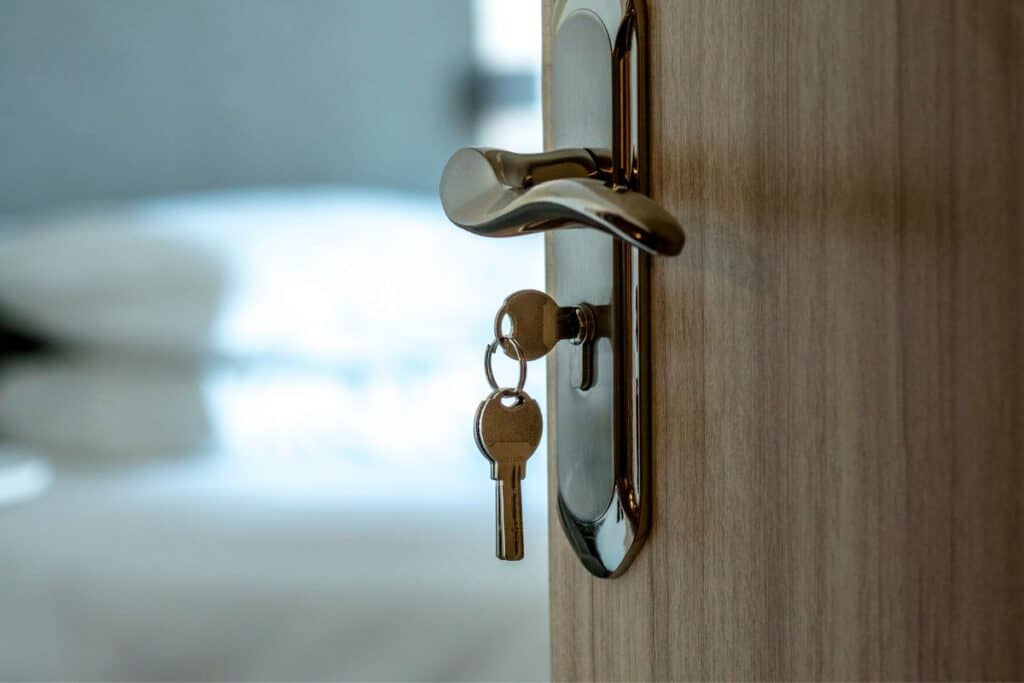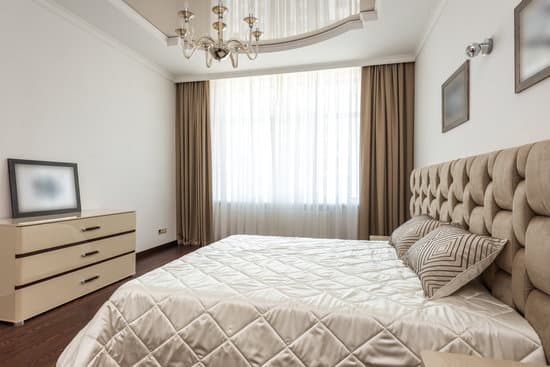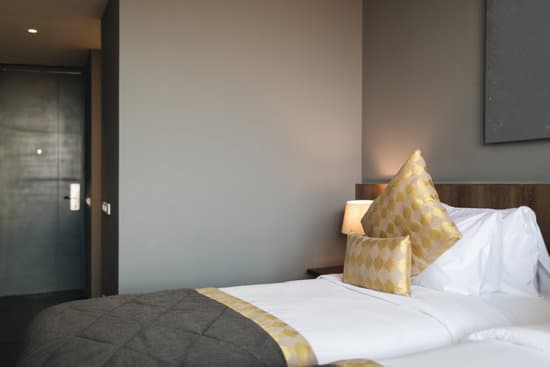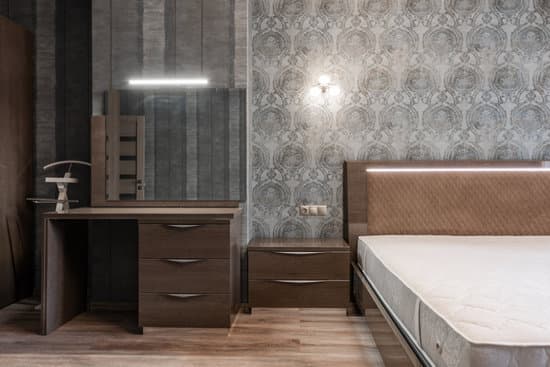Do you sometimes feel like your bedroom isn’t secure enough? Do you worry that someone could gain access to it, even when the door is locked? If so, then making a homemade lock for your bedroom door is an ideal solution. With a few simple materials and some basic instructions, anyone can make their own custom-made lock in no time at all.
This article will provide step-by-step guidance on how to construct a reliable yet affordable lock for any kind of interior door. We’ll show you exactly what supplies are needed and walk through each stage of the process from start to finish. In addition, we’ll share some tips and tricks from experienced DIYers who’ve made these locks themselves with great success. So if you’re looking for an extra layer of security in your home or just want to add some unique flair to your bedroom’s decor, this guide has got you covered!
Making a homemade lock offers many benefits: it keeps intruders out while allowing easy access when necessary; it looks stylish; and best of all — it’s completely free! Don’t wait another minute – read on below and get ready to craft your very own custom lock today!

Components Of A Lock
Creating a homemade lock for your bedroom door starts with gathering the components. You’ll need a lock cylinder, which is typically cylindrical in shape and houses a mechanism that operates when you insert the key. The keyhole plate attaches to the door and serves as an enclosure for the lock cylinder. Then there’s a strike plate, which is mounted onto the door frame and has a hole that allows access to the latch bolt of the lock cylinder. Finally, there’s a latch bolt – this slides into place when turning the key in order to secure your door shut.
Crafting these pieces together requires skill and precision but can be done if you have basic knowledge of carpentry tools such as drills, saws, files and sandpaper. With patience and hard work you can make yourself a reliable security system right at home!
Tools And Materials Needed
Making a homemade lock for your bedroom door is an easy and affordable DIY project. To get started, you will need to collect the right materials: a screwdriver, drill bit, padlock, plywood, and screws.
To begin with, you’ll want to measure the thickness of your door and use that as a guide when selecting the size of the padlock. Next, use the drill bit and screwdriver to make holes in both sides of the door frame where you plan to install the padlock. Then cut two pieces of plywood out so that they fit into each side of the doorframe. Attach them securely with screws to ensure maximum security from intruders. Finally attach one end of the padlock to one piece of plywood while leaving enough slack on either side for it to move freely back and forth when unlocked or locked.
Your bedroom doorway is now equipped with its own homemade lock! With just some basic tools and supplies you can easily make sure your space is secure without breaking the bank.
Step-By-Step Construction Guide
Creating a homemade lock for your bedroom door can provide peace of mind and safety. Here is an easy-to-follow guide to making and installing your own secure lock.
To start, you will need certain tools and materials in order to build the lock. A hacksaw or metal file are essential when constructing the lock body. You should also have some screws, metal rods, and wire on hand. To make sure that no one else can duplicate your key, it’s important to purchase special security pins from a hardware store as well.
Once you’ve gathered all the necessary supplies, you’re ready to begin building the lock! Start by using the hacksaw or metal file to cut two pieces of rod into equal lengths – these will become the main components of your homemade lock. Next attach them together with screws so they create an “L” shape. Now add any additional parts (such as a bolt) if needed; use wire and nuts/bolts to keep everything securely connected. Finally, insert the security pins into place according to manufacturer instructions and you’re done!
Now that your custom lock has been constructed, it’s time to install it onto your bedroom door. Make sure you follow proper safety measures during this process: measure out where exactly you want to fit the new device before drilling holes into either side of the door frame; after attaching both sides together inside the door frame with nails or screws, check again that everything is correctly secured before shutting the door completely shut behind it; lastly be sure to test out how sturdy and reliable your new locking system is – try turning each way several times until satisfied with its performance!
How To Install The Lock
Installing a lock on your bedroom door is an essential part of ensuring that you and your family remain safe. With the right installation instructions, you can easily install a secure lock to give yourself peace of mind. Here are some tips for installing your homemade lock:
- Follow all manufacturer’s instructions carefully when installing the lock. Make sure to read through them thoroughly before beginning the process.
- Check that the components of the lock fit together correctly – there should be no gaps or loose parts. If any adjustments need to be made, make sure they’re done securely so that the door remains closed after installation.
- Securely fasten all screws and bolts into place with a screwdriver or wrench. It’s important that these components are tightened as much as possible for maximum security.
- Test out the new lock by locking and unlocking it multiple times to ensure its smooth operation.
- Inspect the surrounding area around the door frame for any signs of damage or wear-and-tear from previous locks, such as dents in the wood or chipped paintwork. This will help prevent further damage during installation and maintain good quality door security over time.
By following these simple steps, you can confidently install a durable and reliable homemade lock onto your bedroom door – something that ensures both safety and privacy for years to come!
Types Of Locks Available
When it comes to keeping your bedroom door secure, there are a variety of locks available. A padlock is one of the simplest and most affordable options for locking your door from the outside. Padlocks come in various shapes and sizes, so you can find one that fits your security needs.
Another option is a deadbolt lock. Deadbolts provide more protection than a padlock because they’re harder to break or pick open. They also require two separate keys to unlock, making them very difficult for intruders to access without both keys in their possession. Mortise locks, cylinder locks, and door knob locks are other types of traditional keyed entry systems that offer varying levels of security depending on the type you choose. Each has its own advantages and drawbacks so consider researching each before deciding which best suits your needs.
No matter what type of lock you opt for, make sure it’s installed properly and only give copies of the key out to those you trust with your safety. Taking these steps will help ensure peace of mind knowing that no one will be able to enter your room without permission.
Safety Considerations
When it comes to installing a homemade lock on your bedroom door, safety should be your top priority. It is important to review the necessary security guidelines and protocols before beginning any home project. Taking the time to familiarize yourself with safety precautions will ensure that you protect not only yourself but also anyone in close proximity to the lock installation.
Before installing a homemade lock, consider these essential factors: understanding how much pressure the locking mechanism can handle; ensuring that no exposed parts of the doorknob are easily accessible; using screws or bolts appropriate for your specific door type; and seeking out guidance from an experienced locksmith if needed. In addition, check frequently for signs of wear and tear as this could compromise the integrity of the lock protection.
Remember: You want to feel safe in your own space, so take all necessary steps to guarantee proper functioning of your homemade lock!
Benefits Of Making Your Own Lock
Making your own lock for your bedroom door offers a variety of advantages. Firstly, you can have complete control over the security measures that are installed on your own space. A homemade lock gives you the power to decide what materials and components should be used in order to create an effective locking mechanism. This means that you don’t have to worry about purchasing a pre-made lock that may not fit with the current style or design of your room. Another benefit is cost savings; making a DIY lock will save you money compared to buying one from a store. Furthermore, if something goes wrong during installation, it’s much easier and cheaper to fix than if you had purchased a commercial product.
In addition, creating your own lock provides peace of mind knowing that no one else has access to this specific device. Installing a personalised locking system implies further protection for your important belongings since only those who know how it works can open it. You’ll also benefit from having more knowledge regarding locks and their functioning mechanisms, which could come in handy when needing assistance with other types of locked doors around your home or office building. All these benefits make creating a homemade lock an attractive option for many people looking for extra security within their private spaces.
Alternatives To Making A Homemade Lock
Now that you know the benefits of making your own lock, it may be time to consider alternate security solutions. Here are some great options for those who don’t have the tools or skill set to make their own DIY door locks:
- External Door Locks
- Deadbolt Lock: A deadbolt is a type of external door lock with a metal bolt operated by a key, thumbturn, or both and can be installed on any kind of door.
- Rim Lock: A rim lock is an old-fashioned style of lock which operates with a simple latch and catch mechanism. It’s usually installed at the top or bottom of a door frame and secured with screws.
- Digital Locks
- Keyless Entry System: This digital locking system allows users to access their property without keys through either an app on their smartphone or via code entry. They typically require power from batteries in order to work but offer increased security against intruders.
- Biometric Scanner Lock: These digital locks use fingerprint scanning technology as a form of authentication before allowing access into your home or office space. Not only is this one of the most secure ways to protect your possessions, it also adds convenience when entering and leaving spaces quickly!
The choice between these different types of locks will depend largely on budget and need – if enhanced security is what you’re looking for then investing in a digital lock might be beneficial. On the other hand, if aesthetics are important then something more traditional like deadbolts could fit better with the look of your home. Regardless, there are plenty of alternatives available so take some time to research each option carefully before making a decision!
Maintenance Tips
Maintaining your homemade lock is the key to ensuring its long-term durability. First and foremost, lubricating it on a regular basis will help keep moving parts from becoming stiff or stuck. You can use any number of products specifically designed for locks or just go with something like 3-in-1 oil or WD-40. Just spray a bit into each part and work them back and forth until they move smoothly.
When installing your new lock, make sure you get it right the first time – if not, there’s a chance that it won’t be secure enough to protect your room when you need it most. It’s also important to check all screws regularly since loose screws could mean compromised security in the future. Lastly, inspecting the condition of both the door and frame around where your lock was placed should become an essential part of your maintenance routine; this way, you’ll know whether any adjustments are necessary over time so that your bedroom remains safe at all times.
Troubleshooting Common Problems
Making a homemade lock for your bedroom door is not without its challenges. In order to ensure that the lock functions properly, it is important to understand common problems that may arise during installation and use. When troubleshooting any issue with the lock, be sure to consider what type of lock was installed as this will influence how you resolve the issue.
The most commonly encountered problem when installing or using a homemade lock is choosing an incorrect size of components. This can lead to issues when trying to fit parts together or having difficulty getting them lined up correctly for assembly. If you encounter this problem, try opting for different sizes of screws or nuts until you find one that fits perfectly in place. Additionally, if the chosen materials are too thick or heavy then they might cause extra strain on the locking mechanism leading to further difficulties. To avoid these issues, make sure all pieces used for installation are lightweight and suitable for their intended purpose before continuing with construction.
It’s also possible that due to environmental factors like humidity or temperature changes, your material choice could impact the overall performance of your lock. If you notice any inconsistencies such as jamming or sticking while operating the device, then investigate whether changing out certain components would improve functionality-but always check compatibility first! By taking some time beforehand to familiarize yourself with different types of locks available and understanding how they function, you can quickly identify potential problems and take steps towards resolving them early on in your project.
Conclusion
In conclusion, making your own homemade lock for your bedroom door is a great way to secure your home and give yourself peace of mind. With the right tools and materials, it’s relatively simple to construct and install your own lock. Plus, you can customize it however you like! Be sure to maintain your lock regularly so that it stays in good working order. If any problems arise while using or constructing your homemade lock, there are troubleshooting guides available to help you out. Overall, this project can be done quickly with minimal effort – giving you an added sense of security in no time at all!







